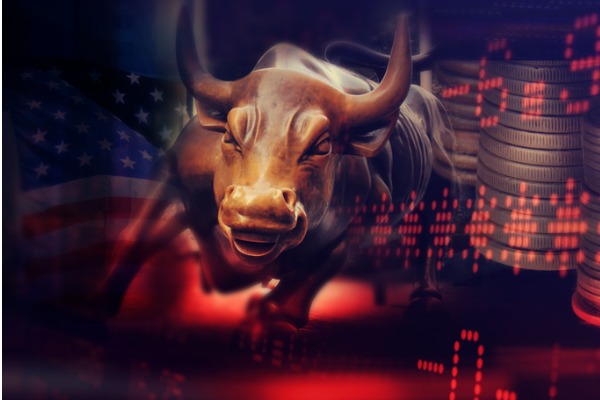Inflation shock gets Wall Street bulls excited again
12th July 2023 15:04
by Graeme Evans from interactive investor
US stocks haven’t traded this high since April 2022 and the S&P is now up nearly 650 points in 2023. Graeme Evans explains what’s triggered the latest round of buying.

Buyers stayed in control of Wall Street markets today after downside surprises on US inflation and core prices raised hopes that the peak for interest rates is now close.
The Dow Jones Industrial Average jumped 300 points and the S&P 500 index lifted 1%, extending the outperformance that has seen the benchmark rally more than 16% this year.
- Invest with ii: Top US Stocks | US Earnings Season | Interactive investor Offers
The FTSE 100 index was already 1.5% higher prior to the better-than-expected release, which showed June CPI of 3% compared with 4% the previous month and 9.1% a year ago.
While base effects from last year’s surge in energy and food prices drove the decline, the main encouragement for Wall Street came from the drop in core prices from 5.3% to 4.8%.
This was the first time in eight months that this closely watched indicator has surprised on the downside, easing some of the pressure on Federal Reserve policymakers after five percentage points of interest rate hikes since March 2022.
Another quarter-point increase is still expected on 26 July, but today’s release and a cooling labour market means they may be tempted to hit the pause button in September.
Projections at the Fed’s recent meeting in June showed the funds rate rising to 5.6% by the year-end, which would mean a further 0.5% of additional tightening.
- Insider: directors think these shares are a bargain
- Barbie and Ken movie hype is just the beginning for Mattel
- Will this results season be a catalyst for cyclical stocks?
Their next decisions will have to consider the lag effects of monetary policy and whether the risks of doing too little outweigh the impact of doing too much.
Deutsche Bank strategist Jim Reid points out that the run of tightening only began when headline and core inflation were 8.5% and 6.5% respectively and came just weeks after the end of quantitative easing.
He said today: “Given that they were extraordinarily behind the curve then, the temptation may be to ensure they don’t stop tightening until the evidence is much clearer that inflation is sustainably back at target.
“That increases the chance of inflation eventually being tamed, but increases the risk of a hard landing.”
For now, however, investors appear hopeful that the current second-quarter results season will represent a trough quarter for US earnings at around 5% lower year-on-year.
This is supported by potential tailwinds from stimulus efforts such as the Inflation Reduction Act, as well as softer year-on-year comparatives and favourable currency movements.
A worsening margin backdrop due to disinflation clouds the investment case, but Bank of America points out that such conditions have been evident most of the past year.
It said: “Half of S&P 500 earnings are goods, where inflation has fallen sharply since Q1 2022. In fact, core goods inflation has re-accelerated in Q2, which has been more correlated to margins than the headline CPI in recent years.
“The pace of margin deterioration also slowed in Q1, and other than commodity sectors, we expect stabilising margins going forward.”
- AI stars Nvidia and Palantir: buy, hold, or sell?
- Why Terry Smith sold Amazon, and how his portfolio is performing
- Merryn Somerset Webb: the scariest chart in the world
Capital Economics still believes a mild US recession over the coming quarters is more likely than not, as the full impact of the surge in borrowing costs feeds into weaker consumption growth, falling business investment and slower inventory building.
It believes that 5.25% and 5.50% should be the peak for this interest rate cycle before the Federal Reserve begins cutting again in the first half of next year. That prospect has boosted the appeal of rate-sensitive growth stocks over recent weeks, with the tech-focused Nasdaq Composite up another 1% today.
In contrast to the encouraging developments in the US, the Bank of England is next month poised to increase rates by another half percentage point. UK inflation is forecast to fall on 19 July, but only from 8.7% to 8.3% as a tighter labour market and a big energy price shock have contributed to a higher rate than seen across the Atlantic.
Economists point out that US inflation would be even lower if statisticians used Europe’s method for calculating the annual rate of consumer prices.
These articles are provided for information purposes only. Occasionally, an opinion about whether to buy or sell a specific investment may be provided by third parties. The content is not intended to be a personal recommendation to buy or sell any financial instrument or product, or to adopt any investment strategy as it is not provided based on an assessment of your investing knowledge and experience, your financial situation or your investment objectives. The value of your investments, and the income derived from them, may go down as well as up. You may not get back all the money that you invest. The investments referred to in this article may not be suitable for all investors, and if in doubt, an investor should seek advice from a qualified investment adviser.
Full performance can be found on the company or index summary page on the interactive investor website. Simply click on the company's or index name highlighted in the article.